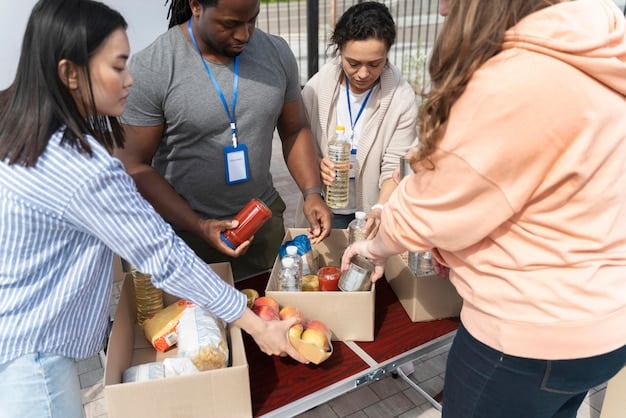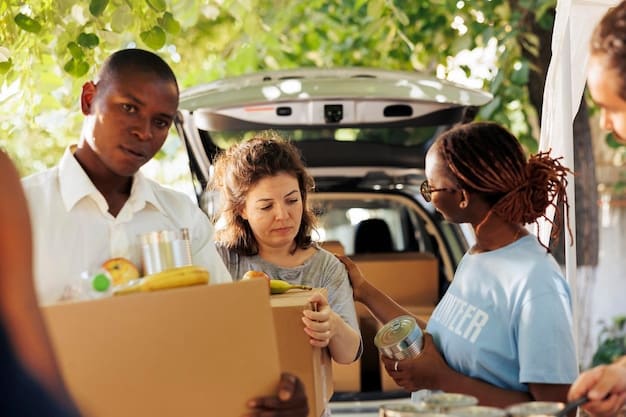Best Practices for a Successful Community Food Drive in the US

Running a successful community food drive involves careful planning, effective promotion, strategic partnerships, efficient collection and sorting, and thoughtful distribution to ensure the food reaches those in need.
Organizing a community food drive can be a remarkably effective way to combat food insecurity and bring your neighborhood together for a good cause. To ensure your efforts have the greatest impact, understanding **what are the best practices for running a successful community food drive?** is essential.
Planning Your Community Food Drive
Before you start collecting cans and boxes, careful planning is crucial. This involves defining your goals, understanding the needs of your community, and setting realistic targets for your food drive.
Define Your Goals
What do you hope to achieve with your community food drive? Are you aiming to provide meals for a specific number of families, or are you focusing on collecting specific types of food to meet particular dietary needs?
Assess Community Needs
Research local food banks and charities to understand the most pressing needs in your area. This will help you tailor your food drive to collect items that are genuinely beneficial to recipients.
- Contact Local Food Banks: Speak directly with food bank representatives to understand their current shortages and priority items.
- Survey the Community: Gather feedback through surveys or informal discussions to identify specific dietary needs or preferences within your community.
- Analyze Demographic Data: Review publicly available demographic data to identify areas of high need and specific populations facing food insecurity.
Proper planning ensures your food drive is targeted, effective, and genuinely helpful to those in need.

Promoting Your Food Drive Effectively
Once you have a solid plan, it’s time to get the word out. Effective promotion is key to maximizing donations and engaging the community. Use a mix of online and offline strategies to reach a wide audience.
Leverage Social Media
Create engaging content on platforms like Facebook, Instagram, and Twitter to spread awareness about your food drive. Share information about your goals, collection dates, and drop-off locations.
Utilize Local Media
Reach out to local newspapers, radio stations, and television channels to request coverage of your food drive. A well-placed news story can significantly boost donations and participation.
Successful promotion builds excitement and encourages widespread participation in your community food drive.
Securing Strategic Partnerships
Collaborating with local organizations and businesses can amplify your efforts and increase the reach of your food drive. Strategic partnerships bring additional resources, expertise, and networks to your cause.
Partner with Local Businesses
Many businesses are eager to support community initiatives. Ask local grocery stores, restaurants, and other businesses to serve as collection points or donate food items.
Engage Community Organizations
Team up with schools, churches, and community centers to expand your reach and tap into existing networks of volunteers and donors.
- Schools: Coordinate with school administrators to organize collection drives among students and staff.
- Churches: Work with church leaders to promote the food drive to their congregations and establish donation sites on church property.
- Community Centers: Utilize community centers as central collection and distribution hubs for the food drive.
Strategic partnerships enhance the visibility and impact of your food drive.

Efficient Collection and Sorting Processes
Efficient collection and sorting are essential for managing donations effectively. Implement a streamlined process to handle the influx of food items and ensure they are properly organized for distribution.
Establish Convenient Drop-off Locations
Make it easy for people to donate by setting up multiple drop-off locations throughout the community. Choose sites that are easily accessible and have ample parking.
Implement a Sorting System
Train volunteers to sort donations according to expiration dates, food categories, and dietary restrictions. This will help ensure that food is safe and appropriate for consumption.
Streamlined collection and sorting processes ensure donations are managed efficiently and effectively.
Ensuring Food Safety and Quality
Prioritizing food safety and quality is paramount to protecting the health of recipients. Implement strict guidelines for accepting, handling, and storing donations to prevent contamination and spoilage.
Accept Only Non-Perishable Items
Focus on collecting non-perishable food items that have a long shelf life and do not require refrigeration. This includes canned goods, boxed cereals, pasta, rice, and beans.
Inspect Donations Carefully
Check all donations for signs of damage, contamination, or expiration. Discard any items that are past their expiration date or show signs of spoilage.
- Train Volunteers: Educate volunteers on proper food handling and safety procedures to minimize the risk of contamination.
- Establish Guidelines: Create clear guidelines for what types of donations are acceptable and unacceptable, based on safety and nutritional considerations.
- Regular Inspections: Conduct regular inspections of storage areas to ensure food items are stored properly and remain safe for consumption.
By prioritizing food safety and quality, you protect the well-being of those who rely on your food drive.
Thoughtful Distribution Strategies
The final step in running a successful community food drive is ensuring that the food reaches those who need it most. Implement thoughtful distribution strategies that prioritize fairness, accessibility, and respect for recipients.
Collaborate with Local Charities
Partner with local food banks, soup kitchens, and shelters to distribute donations to individuals and families in need. These organizations have established networks and expertise in reaching vulnerable populations.
Organize Distribution Events
Host distribution events at community centers or other accessible locations to provide food directly to recipients. Ensure that these events are well-organized and respectful of participants’ privacy and dignity.
Thoughtful distribution strategies ensure that donations reach those who need them most, maximizing the impact of your food drive.
| Key Element | Brief Description |
|---|---|
| 🎯 Planning & Goals | Define objectives, assess community needs, set realistic targets. |
| 📢 Promotion | Use social media, local media to spread awareness. |
| 🤝 Partnerships | Collaborate with local businesses, engage organizations. |
| 🛡️ Food Safety | Prioritize safety, accept non-perishable items, inspect donations. |
How to Run a Food Drive: FAQs
▼
Non-perishable items such as canned goods, pasta, rice, cereal, and beans are highly needed. These items have a long shelf life and provide essential nutrients to those in need.
▼
Check expiration dates, inspect for damages, and only accept non-perishable items. Educate volunteers on proper food handling to prevent contamination and ensure safety.
▼
Yes, consider dietary restrictions or cultural preferences. Include gluten-free, low-sodium, or culturally relevant foods to cater to diverse needs within the community.
▼
Utilize social media, local newspapers, and community newsletters to spread awareness. Partner with local businesses and organizations to amplify your message and reach a wider audience.
▼
Ask businesses to serve as drop-off locations, donate food items, or sponsor the event. Offer recognition for their support to encourage participation and build community partnerships.
Conclusion
By following these best practices, you can create a **community food drive** that not only addresses immediate needs but also fosters a spirit of collaboration and support within your neighborhood. Remember, every contribution, no matter how small, makes a significant difference in the lives of those facing food insecurity.





